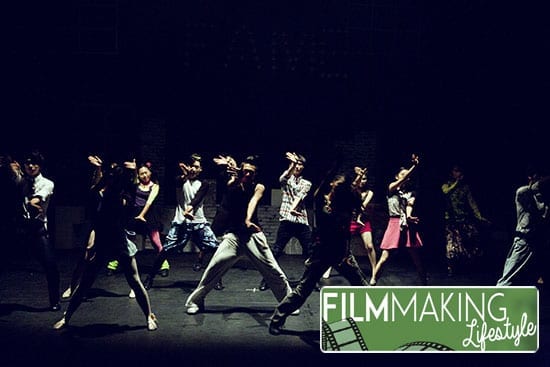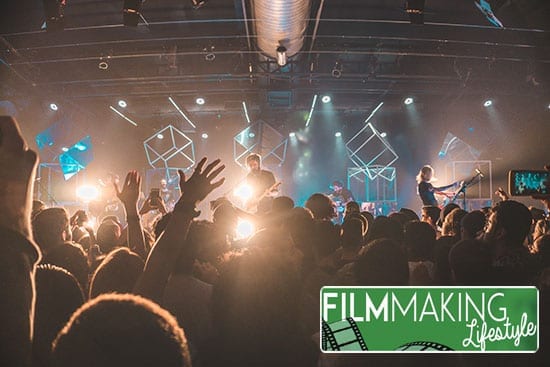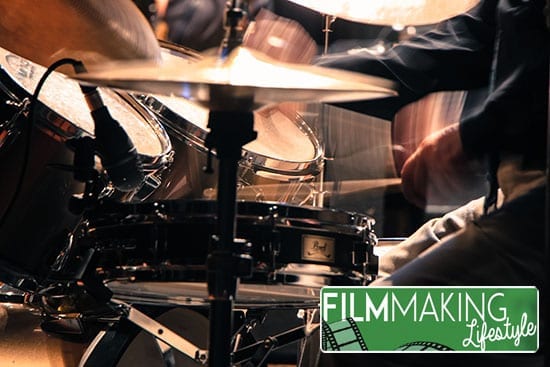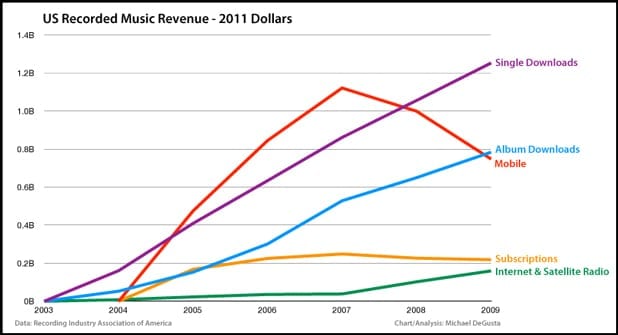So you want to make music videos? Maybe you know a little about music video production, or maybe you’re a newbie.
In this guide, we’re going to cover all aspects of the music video production process: from initial idea, through to the shooting, editing and distribution of the finished video.
Making music videos for bands and recording artists can be a really cool and incredibly rewarding pursuit. Creatively, it can offer you a lot more than simply creating corporate videos for companies. Financially, it can be very rewarding, as the fruits for your labor are plentiful once you start working with well known names.
Let’s get started!
The Business Of Music Videos: How To Make A Music Video And 5 Reasons Why They Can Be Profitable
Introduction
Music videos have always been one of my favorite filmmaking experiences. They are concise, entertaining, and packed with artistic prowess.
What is interesting about them is that there is immediately a set of constraints — timeframe, dialogue, and tone are for the most part decided for you. It does not make things easier, per se, just different.
In the end, you may find yourself unleashed creatively in ways you haven’t yet experienced. In addition to our tips for creative genius, constraints drive creativity!
In his post on Forbes, David Sturt — author of New York Times bestseller Great Work: How to Make a Difference People Love — says:
“Constraints give us a starting point and some building blocks to work with—a problem to solve, an innovative twist to be revealed, or a person to please . . . [Constraints are] a starting point for seemingly endless creativity and possibility.”
This article will cover tips for how to make music videos, including pre-production, how to shoot a music video, the best camera for music videos, and tips for post-production.
I’ll also share a little of the business-side with 5 reasons shooting music videos can be both creative and profitable endeavors!
How To Make A Music Video
We’re going to discuss the various aspects of music video production in this section. First, let’s take a look at a great infographic from Parrot Kreative, which gives a solid breakdown of the various steps in the music video production process:
Creating A Vision (pre-production)
Vision is important because it motivates and gives your team a “north star” to follow. So sit down with your clients and talk about what their vision is or what they want out of this project.
Picking The Song
This is a good first step. Consider the following:
- Length: shooting and editing cost time and money (especially if you are paying a team or renting your equipment); longer songs will cost more
- Audience: who are your clients trying to reach and is the song selection appropriate for that audience? Hint: do you need a “radio version”?
- Video Purpose: is there a specific timeline? For example: is the song coming out soon and the video is meant to be a promotion for the release?
Once you have the song, time to start brainstorming on the creative vision.
Getting Creative Alignment
Creative alignment with your clients is going to be crucial throughout this project. There will be creative decisions that you will make without them, so it’s important to be in sync early.
This creative conversation also gets everyone individually thinking of ideas for shots, storylines and effects that could support the vision.
Here are a couple conversation points that can help you have this conversation:
Long and Slow v. Short and Fast: do they want the type of video that consists of long panning shots, or do they want something with faster cuts?
What’s the Story: do they want to show the song’s story? Do they want to tell a different story? Or do they want to just create a stimulating visual experience?
Imagery and Location: is there anything that they specifically want in the video? Is your artist a “Tropical House” performer who only cares about showing beach and pineapples? A rap artist who wants imagery from the ‘hood? An indie rock band that wants to show how fun their underground shows are?
After this conversation, you will have a song and a bunch of ideas on what you will need to achieve a version of the creative vision.
Setting A Budget
Setting and then working within a budget is something that all filmmakers must get accustomed to. Here is a helpful guide for setting a filmmaking budget and tips from experts to help steer you in the right direction.
If they have a firm budget and low budget in mind then the conversation ends there. If they don’t know or they have a lot of money to spend, then my favorite piece of advice comes from that first link: the idea of providing 3 budget options for clients to choose from, a “gold, silver, bronze” package.
And don’t forget to make sure there’s a little buffer (just in case) and enough to make the business-side of you happy. You are running a filmmaking business after all!
Making A Plan
This is about you and possibly your team sitting down and getting into the details. What equipment do you need? What shots will you need to capture? Where are you filming?
As the plan comes together, continue to check it against your budget estimate. Don’t start production until you’ve checked back in with your clients and get them bought in, otherwise the results might be disastrous.
Pre-production can be time-intensive, but putting the time in early will make an entire project run smoothly. As Andrew Swanson — Owner/Operator/Filmmaker at Filmik — put it your time should be “60% in pre-production, 10% in production, and 30% in post-production.”
How To Shoot A Music Video (production)
Equipment
Refer back to your plan, your budget, your target audience, and your clients to figure out what you need. If you don’t have to invest in something, don’t!
Maybe your client has a YouTube channel and all they’re looking for is a simple video shot using a smartphone to post online for their fans. Maybe they are an athlete looking for GoPro style videos.
Then again, maybe they are Beyonce (one day, Mike… one day).
- Best Camera for Music Videos: cameras come in all shapes and price points. Thankfully, Music Critic recently came out with a helpful list of reviews in of the best cameras to shoot music videos in 2017
- Best Lighting to Shoot a Music Video: lighting can be incredibly fun in music videos, because lighting more than anything will set the mood of your video. Spotlights create stark shadows and gels can color your scene, but most effects should be possible with basic lighting gear.
- Best Sound Equipment to Shoot a Music Video: this part should be easy! You already picked a song, right?
Possible Shots
Here are just some ideas and tips to help fuel your creative juices as you think about the possibilities for how to shoot a music video.
- Live Shows: these can be sources for lots of great footage of the artist and good concert b-reel footage for other projects
- Consider using multiple cameras to capture various angles of the same performance.
- Ask permission to go on stage during the song. Great opportunity for them to engage with camera or to get over-the-shoulder shots looking at the crowd.
- You can always edit down (not up): always be sure to roll camera early and leave rolling late. And if you have the time, don’t be afraid ask for another take. It could save you a lot of time and money later.
- Keep it simple in individual shots (minimize rapid camera movements, zooms, etc.). Much of the “action” in music videos comes from post-production and the speed of the cuts.
- B-roll & stock: there is a lot of content out there, explore it and see if someone has already captured the perfect shot to add to the video. If you do this, pay special attention to rights and make sure you have them!
How To Edit A Music Video (post-production)
Post production brings everything together and I find it to be especially fun for music videos. Here’s a couple tips:
- Make use of the visual indicators on audio tracks to make it easier to transition and match the beats of the video.
- If you have a “baseline” video (a scene or shot that will be consistently returned to), start by lining that up over the audio and splice in other shots from there.
- Follow the plan, but more important is to follow the creative vision. Sometimes you’ll need to improvise, but if you feel like it’s going to impress, then don’t be afraid to go for it.
5 Reasons Why Music Video Production Can Be Profitable
1. Low Barrier To Entry
Personal technology has come a long way and stock footage content is everywhere (remember the rights).
If you have a smartphone, an audio track, a creative vision and the most basic video editing software you have enough to get started for very cheap. It depends what you want to do and the kind of video you want to make. Don’t forget that Tangerine was shot on an iPhone!
2. The Era Of Youtube
Similar to the above, but here’s a mention more specifically of the possibility of creating (or finding a client with) a YouTube channel which can be a profitable venture.
3. Mutual Hustle Mentality
This one is just a term I use for a relationship between people who are in similar places professionally with similar tenacity for success. For example: an up-and-coming artist with an up-and-coming filmmaker.
The mutual hustle mentality can make a creative team that lasts as one or both of you come into fame and success.
4. You Set The Price
Like any filmmaking job, if someone comes to you and wants something, you get to quote them. Consider the budget, the client, and the vision then ensure that your price point includes profit for your business.
5. Creative Jumpstart
Music videos with their constraints can unlock creativity in you that you haven’t found elsewhere. Maybe your first videos don’t rake in profits, but they can give you ideas and skills that are applicable to your other clients. Or they could be just the thing that your next client is looking for.
How To Make A Music Video — Conclusion
Music videos are fun to make and challenge you creatively in ways that you may not have been before. As is the case with most filmmaking, the preparation should take the majority of your time and attention.
Take the time to align with your client’s vision and requirements, make a plan based on that, and then don’t be afraid to make your own creative decisions and improvise.
These can be great tools to get your name out there, attract new clientele, and potentially start relationships with artists that will last into the futures of both of your careers.
There’s never been a better time to get into music video production. As this chart from Business Insider shows, as the online game continues to change the music landscape, single downloads continue to rise (these are 2011 figures, so a little dated but still accurate).
The increase in Single downloads has a direct impact on the number of music videos required, as bands and recording artists need music videos to sell the singles they make:
Good luck and have fun!
Mike Parker: Screenwriter / Freelancer / Actor
Please post any questions and comments in the comments section below. I highly value all feedback (whether you found the article useful or you hated it) as it helps me hone my craft along my own creative journey!
Matt Crawford
Related posts
16 Comments
Leave a Reply Cancel reply
This site uses Akismet to reduce spam. Learn how your comment data is processed.









Realy good article. Many thanks.
Hi Dziri,
Thanks for the comments. Glad you’ve found it helpful.
Cheers,
Matt
You bet !
Thanks, TopsGuy.
I wanted to thank you for all the information that you have provided on making a successful music video. One thing that really stood out to me as I read was that you should have a vision of what you want to do before anything else. Not only is it important to have a vision of how you want to do things, but it is important for you to have a vision in order to motivate and inspire those who are working with you. Thanks again for the information, and I will make sure to let my friend know more about this because she is trying to make it big.
Thanks for the comment, Michael.
Having a vision and then seeing it through to the end is one of the most important things, yeah!
Thanks,
Matt
Your recommendation to sit down with your team in order to make a plan, such as figuring out what equipment is necessary and where to film, would be useful. This could ensure you’re able to figure out what you need to do, such as getting permits or finding a video camera equipment rental shop. Renting your equipment could ensure you’re able to get the best tools without having to pay the full price or figuring out where to store them.
On point, Tiffany. Very true.
Thanks for the comment.
WONDERFUL Post. Thanks for share..
Just wanna say that this is very useful, Thanks for taking your time to write this.
Thanks, Edward – appreciate that.
It’s great that you talked about music videos and what equipment is required to make one! Recently, one of my cousins wants to invest in video marketing. My cousin wants to have a music video for his product idea, so I’ll be sure to share your guide with him! Thank you for the advice on how you’ll need cameras, lightning, and sound equipment for producing a video!
Thanks for the comment, Eli. My pleasure!
I love this post on music video production! It’s so helpful and informative. I’m definitely going to be using some of the tips in my upcoming music video. Thanks for the great advice!
Thanks, Mitchell.
Love these tips! As a aspiring musician, I’m excited to learn more about the process of creating a music video and how to make it successful. Thanks for sharing your insights!
Thanks for taking the time